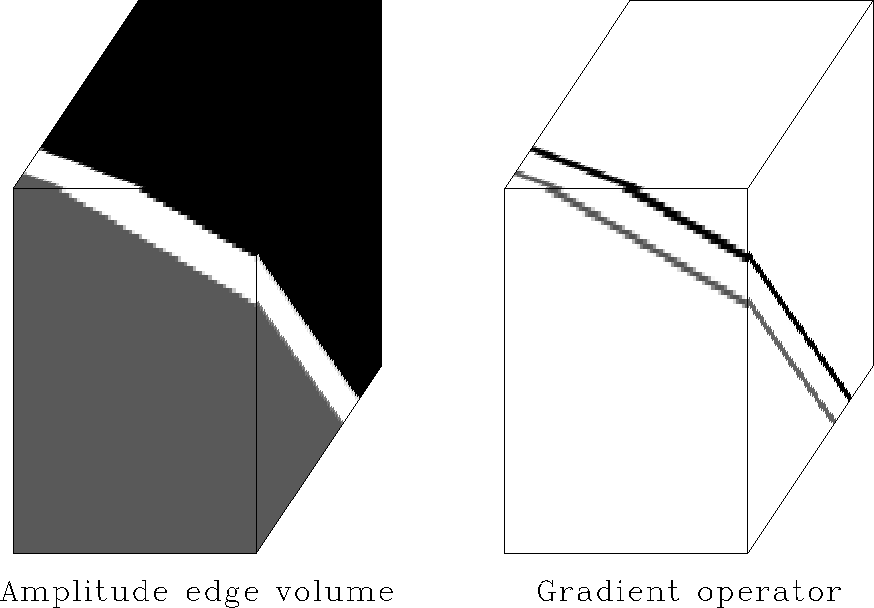




Next: Results
Up: Standard edge detection
Previous: Standard edge detection
In Figure 13,
a gradient magnitude operator
detects the amplitude edges at which pixels change their
gray-level suddenly.
For an image volume  ,the magnitude of the gradient vector
,the magnitude of the gradient vector
|  |
(1) |
assumes a local maximum at an amplitude edge.
The magnitude is zero, if f is constant.
consFoltGrad
Figure 13
Gradient magnitude operator applied to constant amplitude image.
The input image on the left consists of
three regions of constant amplitude.
The output of the gradient magnitude operator on the right delineates
the edges: two parallel plane surfaces.
The pixel amplitudes are all non-negative.
Large amplitudes
in the output image indicate edges in the input image.
Zero output amplitude indicates locally constant input.





In the case of digital images,
partial derivatives are conveniently computed
by finite-difference approximations.
In particular,
I use a three-dimensional generalization of
| ![\begin{displaymath}
\frac{\partial}{\partial x} f(i,j)
=
f(i,j) \ast m_x(i,j) ...
...
\left[
\begin{array}
{rr}
1 & 1 \\ -1 & -1 \end{array}\right]\end{displaymath}](img16.gif) |
(2) |
to approximate the horizontal partial derivative of
this chapter's image volumes.
Table 2 lists alternative
finite-difference approximations of the partial derivative operator.
The various masks vary in their moments,
which affects the operators'
isotropy, robustness and resolution.
Averaging of surrounding values before subtraction
reduces the effect of noise and increases the sensitivity
to gradual grey-level changes.
However,
an increase in operator size causes a decrease in the operator's
ability to resolve
two neighboring edges.
The finite-difference approximations illustrate
the prediction character of the filter:
the difference between the two neighboring pixels is the error
one makes predicting one amplitude value to be the same as the next.
Table 2:
Finite-difference approximations of
the horizontal partial derivative.
| Roberts |
Smoothed Prewitt |
Expanded Prewitt |
Sobel |
Isotropic |
|
|
|
() |
|
|
1 |
|
|
|
| -1 |
0
$ |
|
|
1 |
| -1 |
|
1 |
|
|
| -1 |
|
1
$ |
|
-1 |
| -1 |
-1 |
|
1 |
1 |
| -1 |
-1 |
|
1 |
1 |
| -1 |
-1 |
|
1 |
1 |
| -1 |
-1 |
|
1 |
1
$ |
| -2 |
|
2 |
|
|
| -1 |
|
1
$ |
|
|
| -2 |
|
2 |
|
|
| -1 |
|
1
$ |
|
|
The Derivative Theorem of the Fourier Transform,
shows that the partial derivative operator
scales
each Fourier component of the input image
by its spatial wavenumber in the derivative direction.
Consequently,
the high frequency components that constitute an edge are amplified
and low frequency components that constitute near constant amplitude areas
are suppressed. The zero frequency component is erased.
Additionally,
the derivative operator causes a 900 degree phase shift.





Next: Results
Up: Standard edge detection
Previous: Standard edge detection
Stanford Exploration Project
3/8/1999
![]() ,the magnitude of the gradient vector
,the magnitude of the gradient vector

